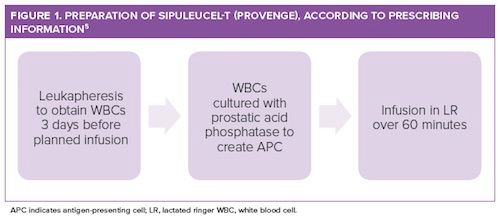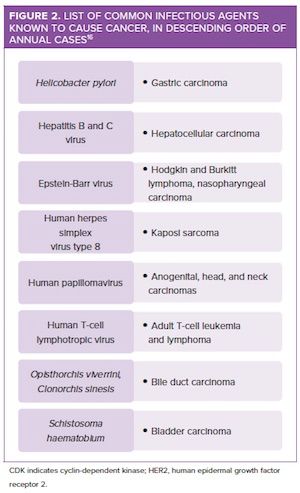Publication
Article
Vaccines Play a Role in Cancer Treatment
Author(s):
There Is Room for Improvement in Treating Malignancies Caused by Infectious Agents, Especially Considering the Cost Differential
The recent measles outbreak in the United States highlights the importance of vaccinations in the prevention of communicable diseases.1
However, vaccines also play an important role in cancer prevention and treatment. The FDA recognizes both the hepatitis B virus (HBV) and human papillomavirus (HPV) vaccines as cancer preventive.2 More recently, a novel, more expensive type of immunotherapy, known as therapeutic vaccines (TVs), has been studied for use in patients who have already received a cancer diagnosis.2-4
Therapeutic Vaccines
FIGURE 1 shows how some TVs are prepared and administered. In general, the body is taught to recognize and attack antigens that are not present in normal host cells.5 Originally, the antigens came from the cells of the tumor itself but required adjuvants or viruses to elicit an immune response. The discovery of more specific tumor-associated antigens and tumor-specific antigens (TSAs), such as p53 and prostate-specific antigen, led to more focused therapy. Additionally, a recent approach has placed the spotlight on neoepitopes, where the antigen is produced by an individual tumor.4

Current Vaccines
TICE BCG, sipuleucel-T (Provenge), and talimogene laherparepvec (T-VEC) are the only FDA-approved TVs.6,7,8 Each has its place in treatment for a particular type of cancer. For instance, in 2010, sipuleucel-T was approved as an autologous cellular immunotherapy indicated for asymptomatic or mildly symptomatic metastatic castrate-resistant prostate cancer. The patient’s own leukocytes are combined with the TSA prostatic acid phosphatase.4 Three doses are given in 2-week intervals,7 which was shown to produce a 4-month greater overall survival compared with the placebo.9 However, this comes at a cost of about $58,000 per dose.10
Preventive vaccines (PVs), on the other hand, have shown their value in the population at large. A randomized controlled trial was published shortly after the first HPV vaccine, Gardasil, came to market and was compared with a placebo. It demonstrated that at 4-year follow-up, none of the patients treated developed cervical intraepithelial neoplasia type 2 or 3 compared with about 2% of the placebo group.11 In the decade since, CDC data have shown that the vaccine is still protective and immunity is not waning. However, requirements for booster injections remain unclear.12 Gardasil 9 entered the market in 2014 with 5 more strains than the previous quadrivalent Gardasil, providing additional coverage against cervical, anal, and throat cancers.13,14 The private- sector price for Gardasil-9 is about $217 per dose.15
Of the common infectious agents linked to cancer (FIGURE 2),16 the only other one with a PV is HBV. Taiwan led the way with a universal HBV immunization program, which a retrospective cohort study demonstrated to have a 75% reduction in hepatocellular carcinoma (HCC).17 In the United States, the private sector price is about $24 for the HBV vaccine and $104 for Twinrix (HBV and hepatitis A vaccine).15 Hepatitis C is another major risk factor for HCC,18 and although no vaccine is available, clinical trials are being conducted.19

On the Horizon
Many approaches to immune regulation of cancers are being studied. The concern with using TVs alone is a lack of robust results to pass phase 3 clinical testing for FDA approval. One reason in the past was the primary end point of progression-free survival, which was commonly used for chemotherapeutic agents, rather than overall survival. Although both come at a high cost, chemotherapy and TVs treat cancer differently. Chemotherapy provides immediate cytotoxic results for tumors, but TVs rely on enabling the immune system to attack the cancer, a longer process.4
Recently, more clinical trials have focused on TVs in com- bination with radiation therapy and systemic cancer treatments to provide a synergistic response. For example, a clinical trial looking at the TV NeoVax, which targets neoepitopes, in combination with a monoclonal antibody and radiation therapy for the treatment of a mutation-specific glioblastoma, is under way.20,21
Conclusion
Both preventive and therapeutic vaccines should be used across the spectrum of care for cancer because they each treat different types of neoplasms. However, it is clear from a managed care perspective that there is still room for improvement in treating cancers caused by infectious agents, especially considering the cost difference in PVs versus TVs. With the FDA recently approving the use of Gardasil up to age 45 in men and women, there is still room for enhanced vaccination rates.22 Clinicians must effectively use the options available to prevent malignancies while awaiting further developments in oncology treatment.
Jerry A. Barbee Jr, PharmD, BCPS, CPh, and Glenn Schulman, PharmD, MS, BCPS, BCACP, BCGP BCIDP, are clinical pharmacists in Pensacola, Florida.Sam Sowell is a PharmD candidate at the University of Florida in Gainesville.
REFERENCES
- Centers for Disease Control and Prevention. (2018). Measles Cases and Outbreaks. [online] Available at: https://www.cdc.gov/measles/cases-outbreaks.html [Accessed 31 Jul. 2019].
- Cancer.Net. (2018). What are Cancer Vaccines?. [online] Available at: https://www.cancer.net/navigating-cancer-care/how-cancer-treated/immunotherapy-and-vaccines/what-are-cancer-vaccines [Accessed 31 Jul. 2019].
- Dana-farber.org. (2019). Tumor Vaccines - Dana-Farber Cancer Institute | Boston, MA. [online] Available at: https://www.dana-farber.org/cellular-therapies-program/tumor-vaccines/ [Accessed 31 Jul. 2019].
- DeMaria, P. and Bilusic, M. (2019). Cancer Vaccines. Hematol Oncol Clin North Am, 33(2), pp.199-214.
- Wei, S. and Millar, L. (2018). Vaccine Therapy for Cancer: The Basics | OncoLink. [online] Oncolink.org. Available at: https://www.oncolink.org/cancer-treatment/immunotherapy/vaccine-therapy-basics [Accessed 31 Jul. 2019].
- Organon Teknika Corporation LLC (2009). Prescribing information for BCG LIVE (FOR INTRAVESICAL USE). [online] Available at: https://www.fda.gov/media/76396/download [Accessed 31 Jul. 2019].
- Dendreon Corporation (2010). Prescribing information for PROVENGE® (sipuleucel-T). [online] Available at: https://www.fda.gov/media/78511/download [Accessed 31 Jul. 2019].
- Amgen Inc. (2015). Prescribing information for IMLYGIC (talimogene laherparepvec). [online] Available at: https://www.fda.gov/media/94129/download [Accessed 31 Jul. 2019].
- Kantoff, P., Higano, C., Shore, et al. (2010). Sipuleucel-T Immunotherapy for Castration-Resistant Prostate Cancer. N Engl J Med, 363(5), pp.411-422.
- Drugs.com. (2019). Provenge Prices, Coupons & Patient Assistance Programs. [online] Available at: https://www.drugs.com/price-guide/provenge [Accessed 31 Jul. 2019].
- Mao, C., Koutsky, L., Ault, K., et al. (2006). Efficacy of Human Papillomavirus-16 Vaccine to Prevent Cervical Intraepithelial Neoplasia. Obstet Gynecol, 107(1), pp.18-27.
- Cdc.gov. (2018). Human Papillomavirus: Questions and Answers. [online] Available at: https://www.cdc.gov/hpv/parents/questions-answers.html [Accessed 31 Jul. 2019].
- Markowitz, L. E., Liu, G., Hariri, S., eta l. (2016). Prevalence of HPV after introduction of the vaccination program in the United States. Pediatrics, 137(3), e20151968.
- Joura, E. A., Leodolter, S., Hernandez-Avila, M., et al. (2007). Efficacy of a quadrivalent prophylactic human papillomavirus (types 6, 11, 16, and 18) L1 virus-like-particle vaccine against high-grade vulval and vaginal lesions: a combined analysis of three randomised clinical trials. Lancet, 369(9574), 1693-1702.
- Cdc.gov. (2019). Current CDC Vaccine Price List. [online] Available at: https://www.cdc.gov/vaccines/programs/vfc/awardees/vaccine-management/price-list/index.html [Accessed 31 Jul. 2019].
- Plummer, M., de Martel, C., Vignat, J., et al. (2016). Global burden of cancers attributable to infections in 2012: a synthetic analysis. Lancet Glob Health, 4(9), e609-e616.
- Chang, M. H., You, S. L., Chen, C. J., et al. (2016). Long-term effects of hepatitis B immunization of infants in preventing liver cancer. Gastroenterology, 151(3), 472-480.
- Chan, S. L., Wong, V. W., Qin, S., & Chan, H. L. (2016). Infection and cancer: the case of hepatitis B. J Clin Oncol, 34(1), 83-90.
- Li, D., Huang, Z., & Zhong, J. (2015). Hepatitis C virus vaccine development: old challenges and new opportunities. Natl Sci Rev, 2(3), 285-295.
- Clinicaltrials.gov. (2019). Personalized NeoAntigen Cancer Vaccine w RT Plus Pembrolizumab for Patients With MGMT Unmethylated, Newly Diagnosed GBM. [online] Available at: https://clinicaltrials.gov/ct2/show/NCT02287428?term=neovax&rank=4 [Accessed 31 Jul. 2019].
- Dana-Farber Cancer Institute. (2015). New Immunotherapy Vaccines Show Promise in Treating Brain Tumors. [online] Available at: http://blog.dana-farber.org/insight/2015/01/new-immunotherapy-vaccines-show-promise-in-treating-brain-tumors/?_ga=2.150300405.276852398.1563895117-2012772441.1563895117 [Accessed 31 Jul. 2019].
- U.S. Food and Drug Administration. (2018). FDA approves expanded use of Gardasil 9 to include individuals 27 through 45 years old. [online] Available at: https://www.fda.gov/news-events/press-announcements/fda-approves-expanded-use-gardasil-9-include-individuals-27-through-45-years-old [Accessed 6 Aug. 2019].







